Siberian Husky Dog Breed Information
The Siberian Husky stands out for its thick double coat, striking blue or multi-colored eyes, and historical role with the Chukchi people of northeastern Asia. These dogs are known for their resilience and ability to withstand freezing temperatures. They’re famous for more than just pulling sleds; their unique personalities make them both amiable and independent, which can be a challenge and a joy for their owners. While their looks might catch your eye, their complex nature and the care they need show how intricate the breed is. Learning about the Siberian Husky’s traits and the duties of their owners sheds light on the close bond between humans and these remarkable dogs.
To truly appreciate a Siberian Husky, you must understand its endearing qualities and care requirements. Their friendly nature and independence often mean they need an owner who understands the balance of affection and firm training. This ensures a harmonious life together. Understanding the Siberian Husky’s background and needs can significantly enhance the bond between these dogs and their human families.
Key Takeaways
- Siberian Huskies have a thick double coat, striking blue or multi-colored eyes, and erect and sharp ears.
- They have a pleasant and noble temperament, with a unique communication pattern favoring howls over barks.
- Siberian Huskies originated in Siberia and played a crucial role with the Chukchi people, being developed for transportation of light cargo across icy terrains.
- They are known for their exceptional endurance and stamina, excelling in sled pulling, and being well-suited for physical resilience and adaptability to extreme conditions.
Quick Facts
Originating from the harsh and frigid landscapes of Siberia, the Siberian Husky is a breed that combines remarkable endurance and a friendly demeanor. It has consistently ranked within the top 30 most popular breeds according to the American Kennel Club and Siberian Husky Club of America since its recognition in 1930.
As medium-sized dogs, males typically weigh 45 to 60 pounds, while females range from 35 to 50 pounds. This breed is lauded for its exceptional vitality, evidenced by a life expectancy of 12 to 14 years.
Siberian Huskies are characterized by their courteous, meticulous, and noble temperament, aligning them with the Working Group. Their utilization in Siberian tribes involved the coordination of packs for transporting light cargo across extensive icy terrains.
The breed’s dense double coat, exhibiting a variety of hues, coupled with its distinctively colored eyes, underscores its adaptation to subzero environments.
Siberian Husky Dog Breed Pictures
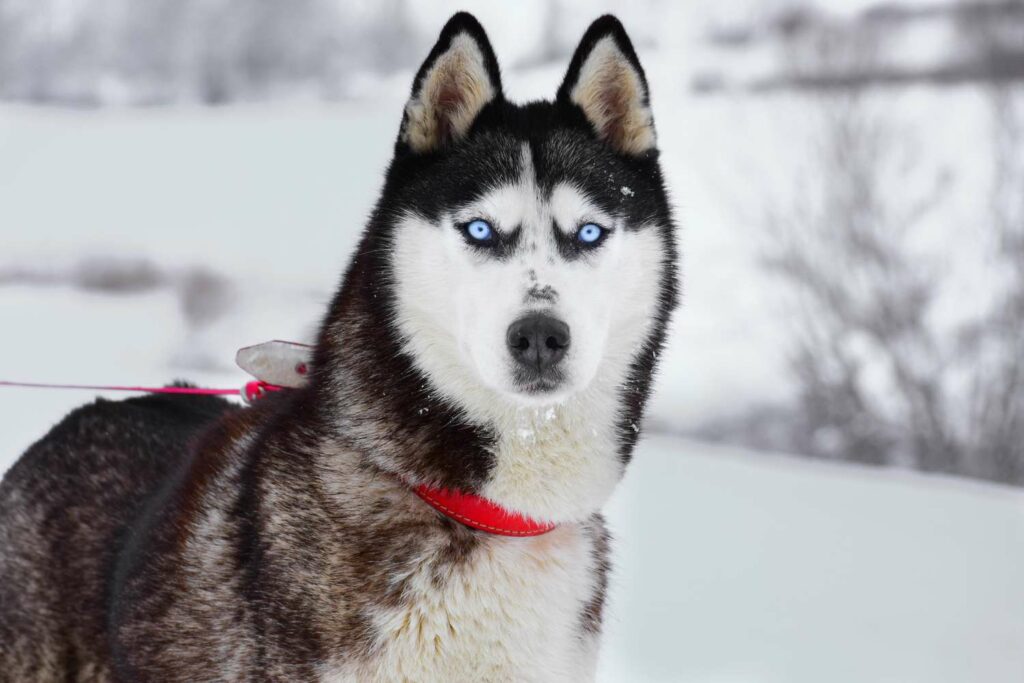
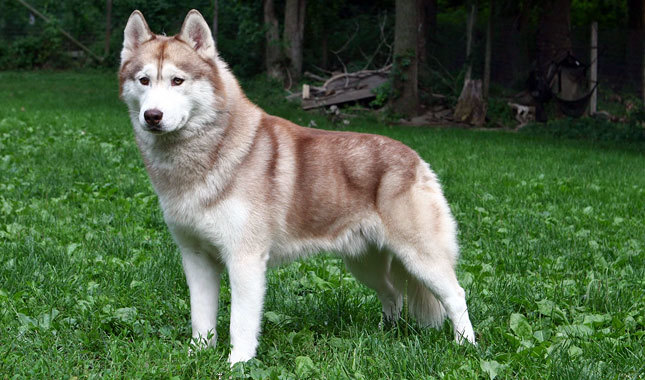
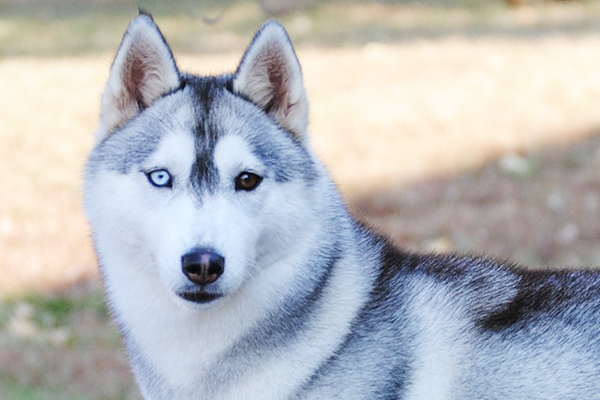
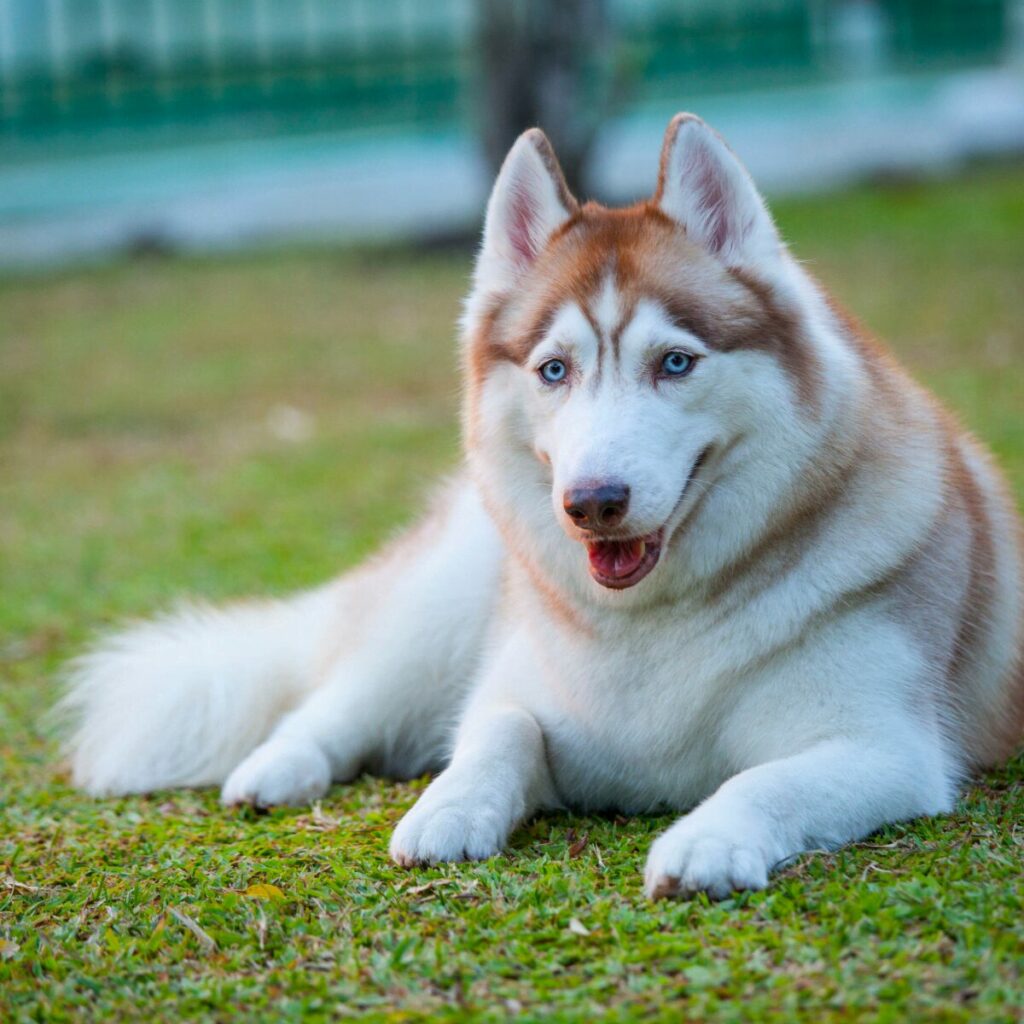
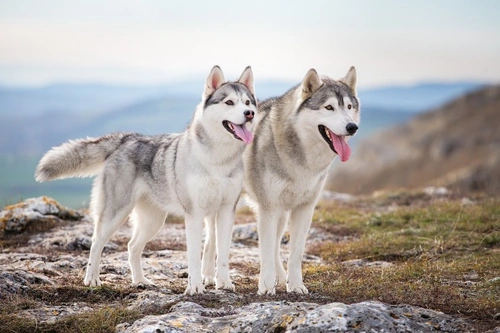
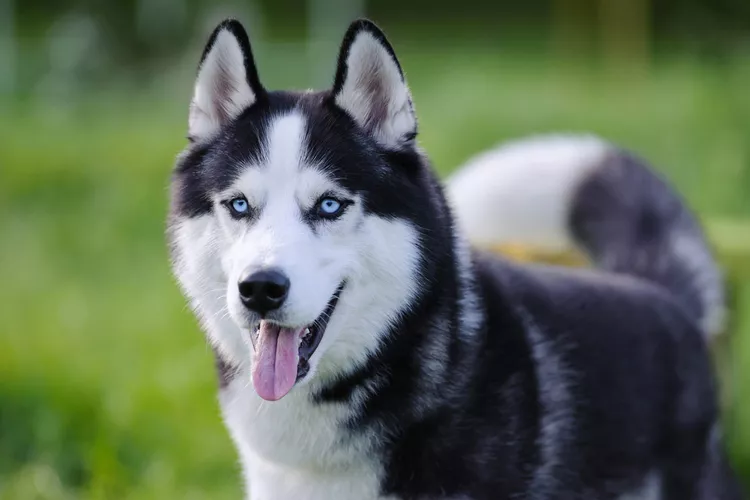
Overview of Pet Parents
Building upon its rich heritage in Siberia, the Siberian Husky has emerged as a versatile breed, renowned for its physical resilience and amiable nature, warranting a comprehensive exploration of its characteristics and behaviors.
As a medium-sized breed, the Siberian Husky is distinguished by a dense double coat and notable ocular pigmentation, which may manifest as blue or heterochromatic hues. These dogs, developed for collaborative work in frigid environments, demonstrate exceptional endurance—a testament to their selective breeding for stamina-intensive endeavors.
Behaviorally, Huskies exhibit a unique communication pattern, favoring howls over barks, and exhibit fastidious and dignified traits. Despite their independent streak, predisposing them to escapism and destructive behaviors, their compatibility with children and potential for cohabitation with smaller animals underscore their adaptability when appropriately trained.
The breed’s genetic origins, tracing back to ancient Lake Baikal canines, reveal a deep-rooted lineage closely related to Alaskan Malamutes and Chukotka sled dogs, underscoring the breed’s historical significance and evolutionary journey.
Siberian Husky Personality & Husky Temperament
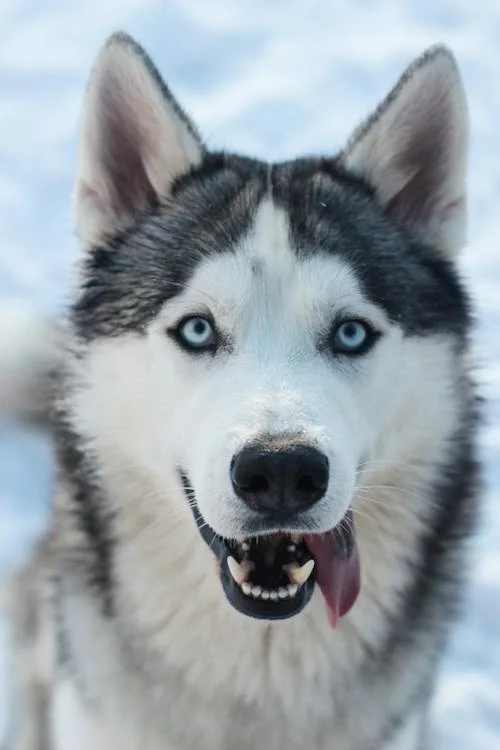
The Siberian Husky boasts a luxurious double coat and sharp triangular ears paired with captivating eye colors that may include shades of blue or a mix of hues. These dogs are friendly, yet they value their independence and are full of energy. Their thick fur requires frequent brushing to keep it in good condition. While their beautiful eyes can sometimes be susceptible to health issues, it’s a reminder to prioritize their care.
As for their living space, it should be well-secured. This is because their natural curiosity and smarts can lead them to attempt escapes, especially since they have a strong instinct to chase. Their remarkable stamina is a nod to their past, where they excelled in sled pulling.
| Feature | Description | Consideration |
|---|---|---|
| Coat | Thick double layer | Needs regular maintenance |
| Eyes | Blue or multi-colored | Watch for health problems |
| Ears | Erect and sharp | Keep an eye on their alertness |
| Temperament | Sociable, self-reliant, lively | Requires plenty of activity and friendship |
Siberian Huskies are great with kids and fit well into family life due to their social nature. They thrive on interaction and are happiest when they’re part of daily activities.
Siberian Husky History
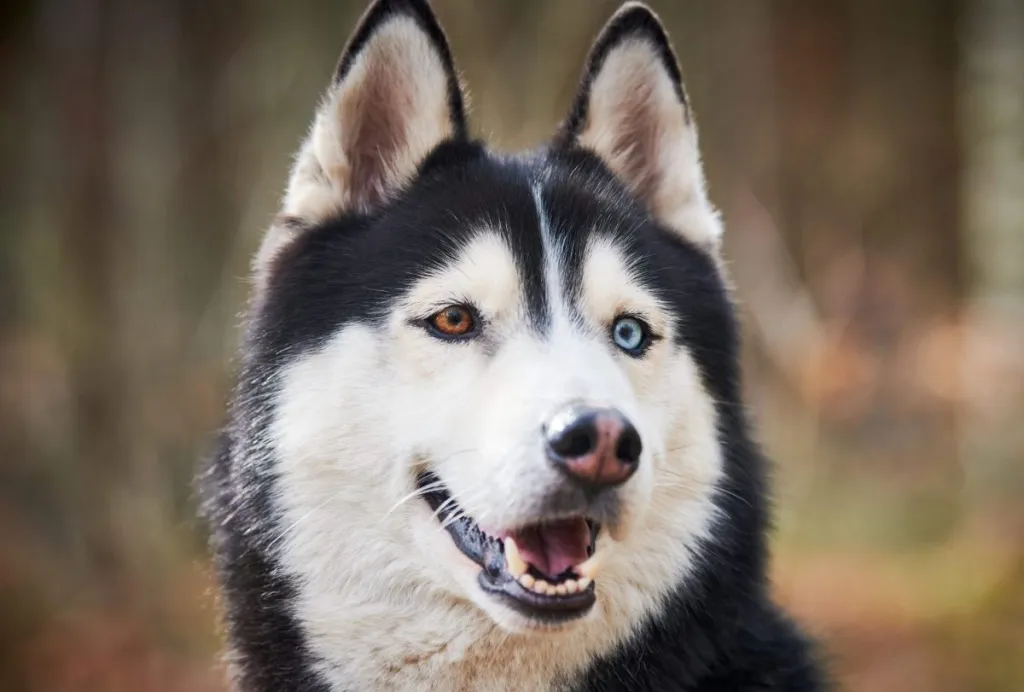
The Siberian Husky boasts a legacy that stretches back to its early days with Arctic tribes. These dogs were crucial for nomads, helping them survive in extreme conditions. Today’s breed emerged through natural pressures in Siberia and careful breeding, earning them a spot in canine breed registries. Their development showcases their adaptability and significance in human endeavors.
Tracing the breed’s ancestry, we find connections to East Siberian dogs and ancient wolves. The Siberian Husky made a name in Alaska during the gold rush, notably in the 1925 serum run to Nome. Figures like Leonhard Seppala were instrumental in refining the breed’s standards. This dog breed is celebrated for aiding human existence in harsh climates. Today, the Siberian Husky is loved for its history and work ethic, making it a favored pet.
The Siberian Husky’s legacy is deeply connected to its Arctic origins, serving as a vital ally to nomadic tribes. Their evolution into a distinct breed has been influenced by the severe Siberian weather and intentional breeding, leading to their acceptance by dog breed registries. This reflects their physical and behavioral adaptations and crucial role in human history and culture.
The breed’s historical roots can be traced back to East Siberian dogs and interactions with ancient wolf species. They were brought to Alaska during the Nome Gold Rush, playing a significant role in the 1925 serum run. Individuals like Leonhard Seppala aided breed recognition and standardization. The breed’s contributions to human survival in subarctic regions are commemorated, and today, their storied past and working heritage inform their status as a beloved breed.
Ancient Arctic Origins
The Siberian Husky has a rich history that dates back over 9,500 years. These dogs are direct descendants of the sled dogs from Chukotka in Siberia and have played a vital role in the life of the Chukchi people. The Siberian Husky was not just a means of transportation but also a valued companion in the extreme cold. Scientific studies confirm their lineage from the original dogs of East Siberia and the Lake Baikal region, showing how well they are suited to the cold Arctic.
The breed was brought to Alaska amid the gold rush, where they became famous for their part in the 1925 serum run to Nome, which was critical in combating a diphtheria outbreak. The American Kennel Club recognized the Siberian Husky in 1930, acknowledging its role as an enduring working dog adapted to the frigid conditions of the polar regions.
Nomadic Companion Development
Over 3,000 years ago, the Chukchi tribe began to develop the Siberian Husky, a dog breed that would become crucial for survival. These dogs were selectively bred for their strength and agility, which made them excellent at pulling sleds. The harsh conditions in Siberia meant that the Chukchi people needed reliable transportation, and the Siberian Huskies provided just that.
The relationship between the Chukchi and the Siberian Huskies was more than just practical. These dogs were integral to the tribe’s way of life, helping them move across the frozen landscape. The bond between humans and Huskies is based on mutual respect and dependence, a testament to the deep connection between people and their working dogs.
Breed Recognition Evolution
Siberian Huskies have a rich history with the Chukchi tribe and became famous worldwide, especially after their crucial role in the 1925 serum run to Nome, known as the Great Race of Mercy. Heroes like Balto and Togo were central to this life-saving mission and helped elevate the breed’s status in the eyes of the public.
By 1930, the American Kennel Club officially recognized the Siberian Husky, celebrating its distinct qualities and skills. With a ranking of 21st in AKC’s popularity list, these dogs are respected for their incredible stamina and strong work drive, from their background of pulling light loads over extensive icy landscapes.
Siberian Huskies are known for their independent nature, keen intelligence, and tendency to howl, all of which make them stand out in the registry of notable dog breeds by the Cynologique Internationale.
Physical Stature
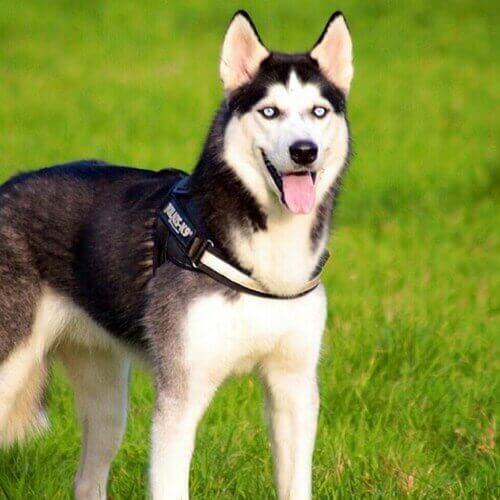
The Siberian Husky is built for the demanding work of pulling sleds, which requires a blend of strength, endurance, and speed. Their height and weight are perfectly tuned for their job, making them agile in the snowy landscape they originate from. Understanding their build sheds light on how they function and reveals their appearance’s beauty, including their remarkable fur, varied eye colors, and other unique features.
- Husky Body Build: Ideal for raw power and long-lasting energy.
- Unique Fur Qualities: Their thick double layer of fur keeps them warm.
- Diverse Eye Colors: Their eyes can be blue, brown, or even different colors in each eye, a condition called heterochromia.
- Tail Style: Their full tail curves over their back when they’re attentive.
- Nose Detail: Their nose can shift color with the temperature, often called ‘snow nose.’
The Siberian Husky’s structure demonstrates its purpose as a hard-working sled dog. Their size is critical to their ability to move swiftly through arctic terrains. A closer look at their traits explains their functionality and emphasizes their striking looks. These characteristics include a thick coat that insulates against the cold, a range of eye colors that add to their mystique, and other notable features.
- Husky Proportions: Designed for both strength and sustained activity.
- Coat Texture: Their dense fur offers protection from extreme cold.
- Eye Color Spectrum: Their eyes vary from shades of blue to brown and may display heterochromia.
- Tail Feature: Fluffy and curved on the back when they are alert.
- Nose Aspect: Their nose may change hues in response to temperature changes, known as ‘snow nose.’
Husky Size Attributes
Siberian Huskies are known for their medium-size and sturdy frames, which make them excellent for their traditional job of pulling sleds. They can cover large distances with ease thanks to their strength and energy. Male Huskies are usually between 21 to 23.5 inches tall at the shoulder and weigh 45 to 60 pounds. Female Huskies are a bit smaller, with heights of 20 to 22 inches and weights between 35 and 50 pounds.
These dogs have a thick double coat that keeps them warm in cold weather, a trait that’s perfect for their sled-pulling heritage. On average, Huskies live for about 12 to 14 years, and their good health reflects their longstanding history as working dogs and loyal companions.
Distinctive Coat Features
Siberian Huskies stand out with their thick double coats that come in a stunning array of colors and designs. Their build is perfect for stamina, and their unique look differentiates them from other dog breeds.
The dense undercoat keeps them warm, while the longer hairs on top protect against moisture and wind. This is especially important for their survival in freezing weather.
Their coats can be as dark as black or as light as pure white, with many shades and unique patterns in between. During shedding seasons, the undercoat thins out in response to changing temperatures.
The bushy fur on their tails may curl up for extra heat, adding to their overall rugged coat. This fur plays a big part in the Husky’s build and history in chilly regions.
Eye Color Variability
Siberian Huskies are known for their distinctive eye colors, which can be anything from dark brown to light blue, and some even have two different colors in one eye. This trait is more than just a pretty feature; it’s a complex genetic characteristic that sets them apart from other breeds.
Siberian Huskies stand out for their wide range of eye colors, unlike most dog breeds that typically have just one standard color.
Their eyes can be brown, blue, black, or even a mix, known as parti-colored. This variety is a clear sign of the breed’s genetic richness and is linked to the variety of colors in their thick coats. Their coats can have shades that go from black to snowy white, which also affects the color of their eyes. It shows there might be a genetic connection between their fur and eye colors.
Tail Appearance
The Siberian Husky has a thick, fluffy tail that isn’t just for looks; it keeps them warm and safe in freezing weather. Born in icy regions, these dogs have a tail that can curl and cover their backside, which, along with their pointy ears, makes them perfect for sled racing.
How their tail arches over their back helps with balance and quick movements, which are vital for a sled dog. The Husky’s tail is a big part of its robust and sporty look and helps it endure long journeys over snowy landscapes.
Nose Characteristics
Siberian Huskies are known for their unique nose colors, which match the variety in their coats. These colors range from black to light pink, and genetics play a significant role in this diversity.
How their noses look, including color and texture, have been shaped by breeders and the need to survive in cold climates. This was important historically, especially during events like the serum run, where dogs had to be tough to withstand freezing temperatures.
The different nose colors, one solid color or a mix, make Siberian Huskies stand out and show how the breed has adapted for endurance in the cold.
Husky Temperamental Traits
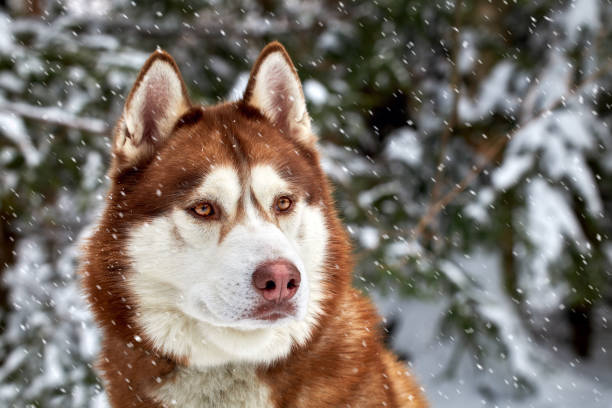
Siberian Huskies are known for their unique temperaments, which shape how they behave and interact with the world around them. They’re intelligent and self-reliant, so training must be handled carefully. Their natural high energy demands consistent physical and mental activity. Understanding their pack-oriented nature and instinct to chase is essential to give them a stable and happy home.
- Joyful at Heart: They need regular play and interaction to keep their mischievous streak in check.
- Clever yet Willful: Their smarts make them quick learners, but they need firm guidance to follow commands consistently.
- Full of Vigor: A vigorous exercise routine is vital to keeping their spirits high and avoiding naughty behaviors.
- Social Creatures: Building their social skills early on is vital due to their strong sense of community.
- Hunter’s Instinct: It’s essential to manage their chasing instincts to keep other animals safe and positively direct their energy.
Siberian Huskies are remarkable but require an owner who understands and respects their needs. With the right approach to training and lifestyle, these dogs can be loving and loyal companions.
Playful Nature
Siberian Huskies are known for their high energy and playful antics. They love interactive play and are very vocal, which is part of their charm. As part of a family, Huskies need a structured routine to help positively focus their energy. Training them consistently and getting used to being around people and other dogs is essential to avoiding stubborn behavior.
These dogs try to escape by digging or chewing if they’re bored, showing their need for regular mental and physical activity. Regular exercise helps Huskies behave better. They love playing games, which helps strengthen their bond with their owners and provides an outlet for their energy.
Intelligence & Independence
Siberian Huskies are known for their playfulness and need for regular exercise and structured routines. Their smarts and self-sufficiency, however, make them somewhat challenging to train and interact with daily.
These dogs were initially bred to cover vast distances and are quite intelligent, but they also have a strong independent streak. This independence was a plus in their traditional roles but can lead to stubbornness when teaching them new commands.
Being escape artists, Siberian Huskies require secure environments to prevent them from running off, as they are clever at finding ways out. When training a Husky, patience and consistency are key. It would be best to respect their intellect but not surrender their willful nature.
They might not be the best choice for first-time dog owners looking for a pet that’s easy to control. Instead, they’re better suited for those who understand and can handle their need for independence.
High Energy Levels
Siberian Huskies come from a background where stamina was crucial, as they were bred to pull sleds over long distances. This breed naturally has a lot of energy and needs plenty of exercise to stay healthy, both in body and mind. They can run and play for hours, showing off their fantastic endurance. Without enough physical activity, these dogs might start acting out.
These dogs are playful and have a strong instinct to chase, sometimes leading to trouble if they’re not adequately trained. Keeping their minds busy with training and games helps prevent them from getting into mischief. Huskies are also known for being quite vocal—they love to howl, which is part of their unique character.
It’s essential for anyone thinking about getting a Husky to be ready to provide lots of exercise and mental challenges. This keeps the dog happy and helps avoid any negative behaviors.
Pack Mentality
Siberian Huskies are known for their teamwork and social behaviors, stemming from their dog sledding origins. These dogs thrive in an environment where they understand their role within a group.
Historically, they had to know their place in the sled team and follow the lead dog’s commands. At home, Huskies look for guidance from their owners, similar to those from a sled pack leader.
Their willingness to work together comes from their ancestry, making them suitable for following orders and working with other dogs.
For Husky owners, it’s crucial to establish clear leadership and communication to manage their behavior and train them effectively.
High Prey Drive Behavior
Siberian Huskies, known for their group instincts, often have a strong urge to chase after smaller creatures. This instinct to hunt and chase can make it challenging to manage them, especially around animals like squirrels and rabbits.
Training that relies on proven methods and early socialization can help control these behaviors. Activities that engage their minds and bodies, like agility courses or obedience lessons, are great for positively directing their hunting energy.
A well-fenced area is crucial to keep Huskies from wandering off after potential prey. Understanding and managing their prey drive is essential to keep them and other animals safe.
Canine Wellness & Common Ailments
Siberian Huskies are strong and resilient dogs but need careful attention to prevent common health problems in their breed. A scientific approach to their wellness highlights the benefits of catching issues early and taking preventive steps. Dog owners should give equal importance to regular healthcare and the specific needs of their Husky.
Regular checks for hip dysplasia are necessary due to their genetic tendency for this joint problem. Since Huskies can inherit certain eye conditions, it’s a good idea to have their eyes checked by a vet every year.
Daily exercise is crucial for these dogs to avoid weight gain and keep their heart healthy. A diet that meets their unique energy needs can help their immune system and keep their fur in good condition. Training and interactive games are vital to keeping their minds sharp and preventing unwanted behaviors.
Siberian Husky Health Overview
Siberian Huskies are generally strong and healthy dogs but can be prone to specific health problems. Genetic issues like seizures, eye disorders, hip dysplasia, and laryngeal paralysis need careful monitoring. To reduce the chance of hip dysplasia, which can cause arthritis, it’s essential to check dogs’ health before breeding them. This involves an x-ray screening of their hips.
For Huskies, staying active is vital for maintaining their health. Regular exercise helps keep their joints in good shape and improves overall health. Owners should ensure their Huskies exercise consistently and see the vet regularly, especially for the puppy. This proactive approach helps prevent health problems from getting worse and helps Huskies live longer happier lives.
Prevalent Husky Conditions
Siberian Huskies often face specific health issues, such as hip dysplasia and eye problems. Owners must keep up with regular vet visits to catch and treat these conditions early. Huskies are generally healthier than other breeds but are still at risk for bone and eye health issues, making preventative care vital.
Consistent vet check-ups can help manage the progression of hip problems. Early screening for eye diseases is also essential due to their common occurrence in Huskies. Their thick double coat sheds heavily sometimes, so regular grooming is needed to keep their skin healthy.
Recent studies have found genetic markers related to Husky behaviors that might affect their risk for conditions such as laryngeal paralysis. This highlights the importance of tailored veterinary attention for each Husky.
Preventative Care Tips
Regular veterinary visits are essential for keeping your Siberian Husky healthy. These check-ups can catch and prevent many health problems. Huskies are strong dogs but need proactive care, such as vaccinations and parasite control.
Proper nutrition and exercise are crucial to preventing weight issues in Huskies. They must stay physically and mentally active due to their high energy and smarts. Watch for health issues like hip dysplasia, eye problems, or breathing difficulties for timely treatment.
Brushing and dental care are essential parts of Husky grooming. These habits help avoid issues that can come from poor hygiene.
Essential Maintenance Needs
Caring for a Siberian Husky involves meeting both their physical and mental needs. It’s essential to follow a regular care routine to keep them healthy and happy, which includes grooming, exercise, proper nutrition, regular vet visits, and training. Each part of this routine is essential for their overall health and happiness.
Grooming them often is critical to managing their thick coat and keeping their skin healthy. They must be active daily to burn off energy, which helps stop them from being destructive. Maintaining a balanced diet helps keep their weight in check and their body running smoothly. Regular vet check-ups can catch and treat health problems early, especially for those familiar with Huskies. Training them consistently is crucial for their mental stimulation and good behavior.
To sum it up, a Siberian Husky thrives with proper care, which includes a mix of physical activity, mental challenges, and health maintenance. Combining these aspects makes your Husky more likely to lead a whole and vibrant life.
Siberian Husky Grooming Routine
A well-rounded grooming routine is crucial for Siberian Huskies to maintain their thick double coat and stay clean. Regular brushing is critical, especially when shedding more, to prevent their fur from tangling and keep their undercoat and outer fur healthy. It’s not just about shedding; brushing helps avoid skin problems in harsh weather.
Bathing every 6-8 weeks with a shampoo made for dogs is essential to keep their skin and fur in good shape. Keeping their nails trimmed is critical to make sure they walk correctly. Cleaning their ears every week helps stop infections, and looking after their teeth regularly is vital to preventing gum disease.
Each part of the grooming process is essential for the health of Siberian Huskies.
Exercise Requirements
Siberian Huskies need plenty of exercise to stay healthy and well-behaved. They should get at least one to two hours of intense physical activity daily. These dogs were initially bred for pulling sleds across the Arctic, so they thrive on strenuous workouts. Activities like dog sledding or skijoring are perfect because they tap into the dogs’ natural abilities.
Without enough exercise, Huskies can become destructive. They’re intelligent and full of energy, and if they don’t get to use it, they can act out. Huskies are also very social animals. They need to spend time with their families or other dogs. It’s crucial to have a secure place to play to keep their curiosity in check and stop them from running away.
Nutritional Needs
Siberian Huskies are high-energy dogs that need a balanced diet to support their active lifestyle. A mix of proteins, fats, and carbohydrates is essential to keep them at a healthy weight. It’s also critical to include the right vitamins and minerals in their meals, especially to maintain their shiny coats and overall health. Omega-3 and omega-6 fatty acids are particularly beneficial.
For Huskies, managing their food intake is critical to preventing obesity, which can be a problem for the breed. Feeding them twice daily in controlled portions can help manage their weight. Access to clean water is a must, especially when they’re most active.
Creating a diet plan with a vet will ensure a Husky gets the specific nutrients they need.
Health Check-Ups
Regular health check-ups are crucial for Siberian Huskies to detect and manage health issues early. These exams should thoroughly review the dog’s condition, from size and weight to overall health, including their eyes, ears, and teeth.
A clinical check might show the need for a diphtheria shot or other vaccines to keep their immune system strong. Health check-ups also help prevent inherited diseases and keep an eye out for parasites.
Talking with the vet during these visits offers valuable information about the dog’s diet, exercise, and behavior, which is critical to taking good care of Siberian Huskies.
Behavioral Training
Training Siberian Huskies is vital for their well-being and helps create a strong bond with their human family. It’s essential to be consistent and show clear leadership to handle their independent and sometimes challenging behavior. Socializing them early and regularly and teaching them to obey helps manage their abundant energy and prevents unwanted behavior.
Because they’re intelligent dogs, rewards and praise motivate them well. Keeping them busy with activities like agility courses or sled pulling helps prevent the mischief they can get into if they’re bored. Without enough to do, Huskies may bark excessively and act out. A regular schedule and setting boundaries are crucial for their feeling of stability and becoming well-behaved family members.
Training
Siberian Huskies require an understanding of their specific traits and needs. A robust and consistent leader must guide their independence and occasional stubbornness. Early socialization and ongoing obedience training are vital in directing their energy positively and preventing behavioral issues. Because they’re bright dogs, rewards and praise are powerful incentives.
Engaging them in physical and mental exercises, like agility or sledding, keeps boredom at bay and curtails any destructive behavior. Huskies can be noisy and disruptive without enough mental stimulation. Thus, a well-structured routine and clear rules are necessary for their well-being and integration into the family.
Popular Dog Breeds Nutritional Requirements
A Siberian Husky’s diet should be carefully planned to match their energy needs, promoting health and endurance. These active dogs require a diet that fits their activity level to avoid excess weight. It’s crucial to choose dog foods based on research that caters to their specific energy needs and helps maintain their physical solid shape.
- Quality protein is critical for building and repairing their muscles.
- A good mix of omega fatty acids is needed for a shiny coat and healthy skin.
- They need carbs that break down slowly for energy that lasts through their active periods.
- Regular feeding times and correct portion sizes can help prevent obesity.
- They must always have water to stay hydrated, vital for their metabolism and body temperature control.
Balanced Diet Essentials
A healthy diet for a Siberian Husky should include high-quality protein, essential for energy levels and muscle maintenance. Healthy fats and complex carbohydrates are vital to meet their active lifestyle needs.
It’s essential to understand their specific dietary requirements, which include a range of vitamins and minerals. For example, vitamins A, B, D, and E, and minerals like calcium, are crucial for a Husky’s overall health and immune function.
Keeping a Siberian Husky well-hydrated is as important as their food. They need constant access to clean water, especially since they are a breed that loves to be active.
Controlling their food intake is necessary to prevent overweight issues, which can happen with excessive eating. A fixed feeding schedule and regular check-ups with the vet help keep a Siberian Husky’s diet on track.
Caloric Intake Guidelines
Siberian Huskies have unique caloric needs that depend on age, weight, and activity. It’s vital for their health and energy levels that their diet is adjusted based on these individual factors.
Huskies come from a lineage of hard-working sled dogs, giving them a metabolism that can handle intense activity and rest periods. An average adult Husky typically needs between 1,000 and 1,600 calories each day. This range considers the differences in their metabolic rates and various physical activity levels.
Dog owners must monitor their Husky’s body condition, adjusting their food intake to avoid weight issues. A diet that’s rich in nutrients is a must for these dogs. When giving treats or supplements, remember these count towards the total daily calories and should be considered to ensure a balanced diet.
To get the best advice on feeding your Husky, talk to a vet who can help tailor a nutritional plan that’s just right for your pet’s needs.
Appropriate Food Choices
Siberian Huskies thrive on high-quality protein to keep their muscles strong and meet their high-energy needs. These energetic dogs, known for their role as sled dogs, need a diet that fuels them and helps them recover after a lot of activity.
It’s essential to include healthy fats, like omega-3s, for a shiny coat and overall well-being, especially since they’re often in cold weather.
Whole grains and vegetables provide the complex carbohydrates that active Huskies need. They give energy without the risk of weight gain, which can lead to health issues.
To avoid overfeeding, managing how much they eat is critical—talking to a vet to create a balanced diet plan to keep these hard-working and protective dogs in great shape.
